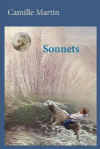Sonnets
Can you pour new wine into old bottles? Well, if you are Camille Martin and the bottles are sonnets, the answer is an emphatic, "Yes." By her flexible use of the idea of the sonnet, Camille Martin has written a book that holds a pleasing balance of unity and variation. In the second sonnet, Martin seems to be speaking to the form as the beloved:
Can you pour new wine into old bottles? Well, if you are Camille Martin and the bottles are sonnets, the answer is an emphatic, "Yes." By her flexible use of the idea of the sonnet, Camille Martin has written a book that holds a pleasing balance of unity and variation. In the second sonnet, Martin seems to be speaking to the form as the beloved:
I gave you all my sense, blind homunculus,
a sea in a sea, but I'm far from broke.
do you love me, zombie? your main products
are indigo, figments, tricks of cardiac debt,
and a defiant sponge. sometimes your vision,
fluorescent and copious, undershines the diamonds
of your rods and cones and you have to wiggle
your way back, salmon-like, up the information
spillage to the enchanted vapour. you preen
your molecules, all the while scorning the witness
of your deposed gleam, and on your own
little hillside, your own fraudulent
elsewhere, flashing your mirrors into the sun,
you grow roots of endless delay.
The internal rhyme in this poem (sea and zombie, sometimes and undershines) as well as the clash of diction "blind homunculus," "the information / spillage to the enchanted vapour" prepare the reader for Martin's playful approach to the form. This is a world where science and myth intersect. Even more importantly, the intensity of the language reveals Martin's urgent preoccupation with both form and fragments of narrative.
Martin's interpretation of the sonnet is as a 14 line poem where the syllabic count varies from lines as short as 4 syllables in part 5 of tellurium candies "bulging magma gathers," or even the single syllable first line of "snow." Other poems such as "a simpleton inherits a kingdom after unwittingly avoiding" have lines of more than 20 syllables.While this may make some formalists uncomfortable, the technique of varying the syllable count opens up the form for most readers, allowing for a flexible balance between narrative and image with form.
Most of the poems in this book are from the perspective of the poet reflecting on language and experience (including the excellent series "the street names of toronto") but I'd like to end this discussion by looking at one of the love poems which comes near the end of Sonnets:
her green sweater, caught in a revolving
door that reflects clouds frittering away
like flour blown off a wooden cutting
board. she looks back. she has no
shadow. thoughts of the shortness
of ant seasons, and whether omens will ever
mean what they mean before coming true.
her eyes, transparent holes in the sky.
light fades into a dusk riddled
with dim constellations and vanishes
into their unconnected dots,
like knots in a magician's scarf.
the key to unhooking her sweater
is a tangled up, long, long time.
In this poem, the line between address to self and other are fruitfully elided while the poet plays with the perceptions of times "the shortness of ant seasons," or "the key to unhooking her sweater is a tangled up, long, long time." The poem also alternates between the domestic "flour blown off a wooden cutting board" and what we take as larger like the sky or omens.
Camille Martin's Sonnets provide many pleasures for the reader who spends time in their world of a mind reflecting on itself, the natural and built environments, time, and language.





